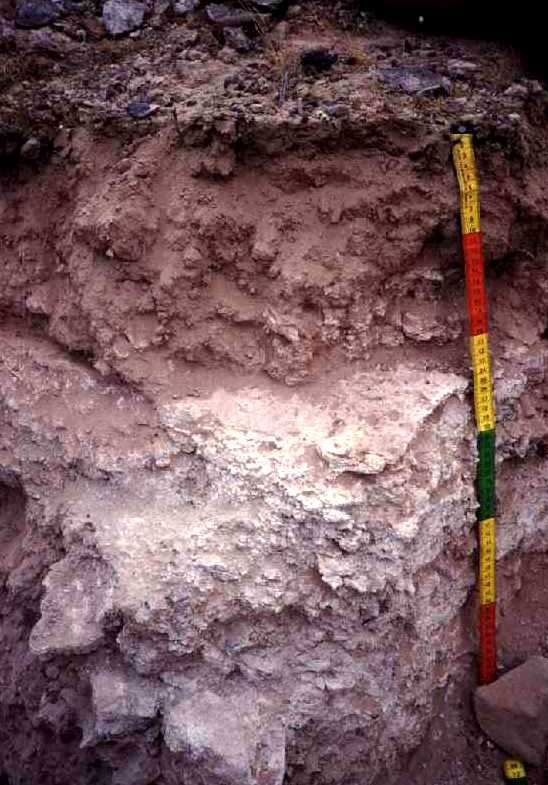 Soil Formation in the Verde Valley - June 15, 2016 Jeff Schalau, Agent, Agriculture & Natural Resources University of Arizona Cooperative Extension, Yavapai County Soil is one of the most critical life-sustaining resources we have on earth. Without well-developed, fertile soil, most crop plants would simply not produce the quantities of food and fiber the human population currently needs to survive. Wildland soils are also critical to the natural systems they support. During the brief overview that follows, consider how you personally depend on the soil, both in your garden and for the products you need. Soil genesis begins with the parent material. In the Verde Valley the parent material could be a sedimentary rock, such as the limestone of Rimrock or the sandstone of Sedona, an igneous rock, such as basalt from House Mountain, a metamorphosed rock found near Jerome, or alluvial deposits on a river or stream terrace. By the way, these alluvial soils are the deepest, most fertile soils in the Verde Valley. Climate determines the rate of weathering. In our arid climate, water is the limiting factor that determines the rate of soil formation. In Arizona, soil develops more slowly than in humid areas such as the tropics. Living organisms are also major contributors during soil development. Native vegetation, soil microbes, animals (including microscopic multicellular organisms, worms, insects, and vertebrates such as gophers and humans) all contribute organic matter, decompose, and redistribute carbon and mineral nutrients to soil. The shape of the land surface (topography) also plays a major role in soil genesis. On steep sites, gravity causes fast runoff and debris slides on slopes. The runoff carries sediment and deposits it after the energy of the flowing water is reduced. Flat surfaces retain precipitation and runoff better than the slopes. Time is another critical soil forming factor. The amount of time needed for soil development varies with the other soil forming factors, but the minimum would be 30-50 years. As discussed above, parent material, climate, organisms, topography, and time are the factors influencing soil development. How do you know if soil is developed? Usually this means that the soil has gone undisturbed long enough for distinct horizons to be visible. Soil horizons can often be seen clearly on road cuts. You may notice a darker layer at the soil surface. The darker color is from humus: organic acids that are resistant to microbial decomposition and produced by input of organic matter. We don't see very much humus in native Arizona soils due to our high temperatures which increases the rate of organic matter decomposition. Aside from color, soil horizons also have differing textures (relative amounts of sand, silt, and clay), chemical properties, and amounts of plant roots and microbial activity. Soils high in sand have good drainage and aeration (to a fault) but poor nutrient availability and water holding capacity. Conversely, clay soils often have slow drainage and less available oxygen but have increased water and nutrient holding capacity. Silty soils, or loams, have the best combination for good drainage and aeration, yet they can retain a ready supply of plant available water and nutrients. Many of the soils found on the old Verde River terraces are loams. One soil challenge facing many Verde Valley gardeners is caliche. Caliche is a cemented layer of calcium carbonate that inhibits root penetration and water movement while also raising the pH of the soil. Caliche forms in arid climates because limited rainfall leaches the calcium carbonate to a given depth and no further. Here it accumulates and cements the soil particles and rock fragments together. This can lead to a loss of vigor in plants due to poor drainage. In addition, the elevated pH frequently causes plant nutrients, such as iron, to become less available. If you must plant in caliche, you can either fracture it with a jackhammer or import soil to increase the soil depth in the area to be planted. So, remember the importance of soil. It's a resource that is not easily replaced. Are you wearing cotton? Do you use any wood products such as rayon? Do you like to eat? If any of your answers are “yes”, then you need soil. Follow the Backyard Gardener on Twitter – use the link on the BYG website. If you have other gardening questions, call the Master Gardener help line in the Camp Verde office at 928-554-8992 or e-mail us at verdevalleymg@gmail.com and be sure to include your name, address and phone number. Find past Backyard Gardener columns or provide feedback at the Backyard Gardener web site: http://cals.arizona.edu/yavapai/anr/hort/byg/. |